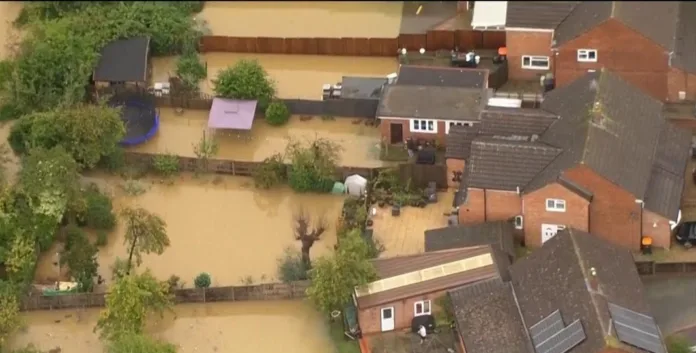Record rainfall causes widespread flooding, travel disruptions, and property damage across multiple regions.
Heavy rain and flash floods wreak havoc across England and Wales, leading to significant travel disruptions and extensive property damage. In just a few hours, some areas received a month’s worth of rainfall, overwhelming local infrastructure and causing severe flooding.
Central and southern England witnessed some of the most significant impacts, with the River Thames overtopping its banks in London. Residents navigated flooded streets, and emergency services responded to approximately 350 flood-related calls in the capital alone. In Bedford, a major road was completely submerged, leading to chaotic traffic conditions.
The Met Office issued an amber weather warning for parts of central and southern England, which expired at 21:00 BST, but a yellow warning remained in effect for the rest of England and southeast Wales. This yellow warning indicates the potential for further disruptions due to heavy rain, including possible power outages and travel delays. The Environment Agency responded by issuing more than 20 flood warnings and over 80 flood alerts, particularly affecting areas like Leighton Buzzard, Luton, and parts of London.
One of the most dramatic scenes unfolded on the A421 main road between Bedford and Milton Keynes, which closed due to severe flooding. Local rail services also faced disruptions, affecting commuter travel significantly. In Marston Moretaine, residents banded together to rescue stranded animals from a local farm. Joanna Johnson, a resident, described how nearly 50 neighbours responded to her emergency plea on social media, helping to save miniature ponies and sheep trapped in chest-high floodwaters.
Jon Sayle, a resident in the village of Grendon, shared his disbelief at the rapid flooding, noting that approximately two feet of water seeped into his home overnight. Another resident, Lee Elliott, recounted helping push stranded vehicles out of the floods, highlighting the community spirit that emerged amid the crisis.
The London Fire Brigade reported attending to numerous emergencies related to the flooding, rescuing individuals trapped in vehicles and assisting those stranded in homes. They warned the public on social media that even a foot of moving water could float a car, urging caution.
Transport for London announced that several Underground lines faced delays or suspensions due to flooding, affecting the District, Circle, Metropolitan, Piccadilly, Bakerloo, and Central lines. National Rail reported widespread disruptions and cancellations, advising passengers to check their travel plans before heading out.
In addition to travel issues, multiple schools in Bedfordshire and Oxfordshire were forced to close, with some switching to remote learning. Homes and businesses also suffered damage from the unexpected flooding.
A sinkhole formed on the pitch of AFC Wimbledon’s Cherry Red Records Stadium, prompting the postponement of their upcoming Carabao Cup fixture against Newcastle United. The club announced that the stadium would remain closed until further notice due to flooding in the surrounding areas.
The severe weather system, characterized by a slow-moving area of low pressure, has brought multiple waves of rain to southern England since late Friday. Thunderstorms struck areas around Luton and Dunstable, leading to record rainfall in a short time frame. While the worst of the weather is expected to ease by Monday evening, additional rain could follow, particularly on Wednesday, as colder Arctic air sweeps across the UK, resulting in significantly lower temperatures.
Analysis:
Political:
The severe flooding and its aftermath have significant political implications for local and national governments. Effective disaster response and infrastructure management are crucial in times of crisis. Public perception of government preparedness will likely influence upcoming elections, particularly as constituents assess how well their leaders handle emergencies. This flooding incident may trigger discussions on environmental policies and climate change, prompting politicians to prioritize long-term solutions to enhance community resilience against extreme weather events.
Social:
The floods highlight the importance of community solidarity in times of crisis. Residents in affected areas demonstrated remarkable unity by mobilizing to assist one another, showcasing the strength of local networks. This communal response can foster a greater sense of belonging and trust among neighbors, but it also underscores the need for systemic support from government agencies. Vulnerable populations, such as the elderly and low-income families, often bear the brunt of such disasters, leading to discussions about social equity and resource distribution during emergencies.
Racial:
The impact of flooding can disproportionately affect racially diverse communities, which may have less access to resources for recovery. Discussions around racial inequality become particularly relevant during crises, as marginalized groups often experience higher levels of vulnerability. Ensuring equitable access to emergency services and recovery resources is vital for fostering inclusive resilience, prompting calls for targeted assistance for at-risk populations in the wake of natural disasters.
Gender:
Gender dynamics play a role in disaster recovery, as women often take on caregiving roles and face unique challenges in accessing resources. During emergencies, women may encounter barriers in securing aid and support due to societal expectations or logistical constraints. Understanding these gendered experiences can inform better policy responses, ensuring that recovery efforts are inclusive and address the specific needs of all community members.
Economic:
The economic ramifications of the flooding are significant, affecting local businesses, transportation networks, and public services. Disruptions in travel and commerce can lead to financial losses for businesses, compounding the challenges faced by communities. As governments assess recovery efforts, they must consider economic resilience, investing in infrastructure improvements and support systems that can mitigate the impact of future disasters. The floods may prompt discussions about insurance coverage and the need for enhanced financial protection for affected households and businesses.
In conclusion, the recent flooding in England and Wales serves as a stark reminder of the vulnerabilities communities face in the face of extreme weather. As residents work to recover from this disaster, broader conversations surrounding political accountability, social solidarity, racial equity, gender inclusivity, and economic resilience will shape the future of emergency response and disaster preparedness in the UK.
